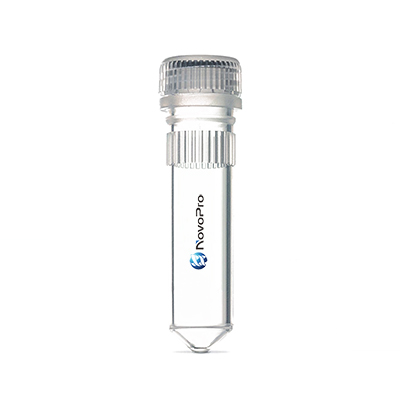- 序列:Gu-ONNRPVYIPRPRPPHPRL-OH (Gu = N,N,N’,N’-tetramethylGuanidino and O = L-ornithine)
- 分子式:C104H171N37O22
相关文档
批次之间数据可能略有差异
产品详情
-
产品名称
Api137多肽
-
序列
Gu-ONNRPVYIPRPRPPHPRL-OH (Gu = N,N,N’,N’-tetramethylGuanidino and O = L-ornithine)
-
长度 (aa)
18
-
多肽纯度 (HPLC, %)
93.95
-
分子式
C104H171N37O22
-
分子量(Da)
2291.4
-
来源
固相合成
-
描述
Api137, a derivative of the insect-produced antimicrobial peptide apidaecin, arrests terminating ribosomes using a unique mechanism of action. Api137 binds to the Escherichia coli ribosome and traps release factor (RF) RF1 or RF2 subsequent to the release of the nascent polypeptide chain. A high-resolution cryo-EM structure of the ribosome complexed with RF1 and Api137 reveals the molecular interactions that lead to RF trapping. Api137-mediated depletion of the cellular pool of free release factors causes the majority of ribosomes to stall at stop codons before polypeptide release, thereby resulting in a global shutdown of translation termination.
-
储存指南
一般情况下, Api137多肽 粉末应该保存在-20甚至-70摄氏度. Api137多肽 溶解后应该-70摄氏度分装保存,避免反复冻融. 了解更多细节,请查阅手册:多肽溶解及保存指南
-
参考文献
- Florin T, Maracci C, Graf M, et al. An antimicrobial peptide that inhibits translation by trapping release factors on the ribosome. Nat Struct Mol Biol. 2017
- bioRxiv preprint doi: https://doi.org/10.1101/2020.05.17.100735. this version posted May 20, 2020.
- Mardirossian M, Barrière Q, Timchenko T, et al. Fragments of the Nonlytic Proline-Rich Antimicrobial Peptide Bac5 Kill Escherichia coli Cells by Inhibiting Protein Synthesis. Antimicrob Agents Chemother. 2018;62(8):e00534-18. Published 2018 Jul 27. doi:10.1128/AAC.00534-18
- Meydan S, Marks J, Klepacki D, et al. Retapamulin-Assisted Ribosome Profiling Reveals the Alternative Bacterial Proteome. Mol Cell. 2019;74(3):481-493.e6
- Adio S, Sharma H, Senyushkina T, et al. Dynamics of ribosomes and release factors during translation termination in E. coli. Elife. 2018
- Florin T, Maracci C, Graf M, et al. An antimicrobial peptide that inhibits translation by trapping release factors on the ribosome. Nat Struct Mol Biol. 2017;24(9):752-757
-
关于三氟乙酸盐
三氟乙酸(Trifluoroacetic acid,简称 TFA)是高效液相色谱(简称 HPLC)纯化过程中常用的反离子。TFA 的存在可能会对肽的净重量、外观及溶解度产生影响,具体如下:
对净重量的影响:TFA 盐会增加产物的总质量。在大多数情况下,肽的含量占总重量的 80% 以上,剩余部分则为 TFA。
对溶解度的影响:TFA 盐通常能提高肽在水溶液中的溶解度。
在生物检测中的影响:对于大多数标准的体外检测,残留的 TFA 水平一般不会造成干扰。但需注意,在高灵敏度的细胞研究或生化研究中,需关注其存在可能带来的影响。
-
关于多肽净含量
干品多肽的重量中不仅仅包含多肽,还包含有一些非肽的组份,如水、被吸收的溶剂、配位离子和盐等。肽的净含量是指肽在其中的重量百分比,这个百分比的数值范围很大,可能从50%到90%,取决于纯度、序列以及合成和纯化的方法,不要将肽的净含量和肽的纯度混为一谈,他们是两个完全不同的概念。纯度通常是通过HPLC测定的。纯度定义的是多肽样品中含正确序列的组分的百分比,而肽的净含量是指样品中肽类物质相对于总物质所占的百分比,肽的净含量通常是氨基酸组分分析或紫外分光法测定的,这个信息主要是在一些对肽的浓度很敏感的实验中,对计算肽的浓度是很重要的。
-
摩尔浓度计算器
-
稀释计算器
-
百分比浓度计算器
质量 (g) = 浓度 (mol/L) × 体积 (L) × 分子量 (g/mol)
相关服务
多肽合成服务: 纽普生物(NovoPro)提供常规多肽合成、糖修饰多肽合成、稳定同位素标记的多肽合成、磷酸化多肽合成、荧光标记多肽、多肽的BSA/KLH/OVA等载体蛋白的偶联等服务。
